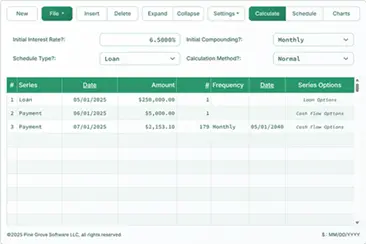Rule-of-78s Loan Calculator
An Introduction to Rule-of-78's Calculator
The Rule-of-78s, also known as the Sum-of-the-Digits method, is a method used by lenders to calculate a loan's interest charges.
The result is that borrowers pay more interest in the early months of the loan term, and less interest in the later months. This can be disadvantageous for borrowers who wish to pay off the loan early, as they will pay a larger portion of the total interest charges earlier than if they had had a traditional loan.
The Rule-of-78s method is not commonly used today, as many countries have banned its use due to the potential for unfairness to borrowers. Most lenders now use the simple interest method or the daily interest method to calculate interest on loans.
The Calculator-Calculate a Loan Schedule Using Rule-of-78s
Information
Additional instructions for the Rule-of-78s calculator
- Loan Amount: Enter the total principal amount of the loan. This is the amount that you will be required to pay back, along with any interest charges, over the course of the loan term.
- Number of Payments: Enter the number of payments that you will be required to make to pay the loan back in full. This must be expressed as the total number of periods depending on the payment frequency.
- Annual Interest Rate: Enter the annual interest rate that will be charged on the loan.
- Payment Amount: Enter the amount that you will be required to pay on each payment due date. This can be calculated based on the loan amount, the number of payments, and the interest rate.
Above are the "primary user inputs." Any one may be set to "0" and the calculator will calculate the value.
- Payment Frequency: Enter the frequency at which payments will be due. This can be expressed as monthly, quarterly, semi-annually, annually, etc., depending on the terms of the loan.
- Compounding: Enter the frequency at which interest will be compounded. If you are not sure what the compounding frequency is, then set it to equal the payment frequency. Compounding is the process of adding the interest that has been earned to the principal balance of the loan, so that interest charges can be calculated on the new, higher balance.
- Payment Method: Loans are paid-in-arrears. That is, the first payment is due one payment frequency after the loan originates. Leases, on the other hand, are paid-in-advance. That is, the first lease payment is made on the day the lease is signed.
Above are the "secondary user inputs." They must all be set. In the event you are not sure, however, you may leave them set to their default values.
If you try one of the above, just set the "Amortization Method" to "Rule-of-78s."
Rule-of-78s Calculator Help
Rule-of-78s loans are declining in use, but should you need to create a schedule for one, use this calculator. You can check out our "Reading Room" for an article about how a Rule-of-78s loan works.
This calculator will solve for any one of four possible unknowns: "Amount of Loan", "Number of Payments" (term), "Annual Interest Rate" or the "Periodic Payment".
Enter a '0' (zero) for one unknown value.
The term (duration) of the loan is a function of the "Number of Payments" and the "Payment Frequency". If the loan is calling for monthly payments and the term is four years, then enter 48 for the "Number of Payments". If the payments are made quarterly and the term is ten years, then enter 40 for the "Number of Payments".
Normally you would set the "Payment Method" to "Arrears" for a loan. This means that the monies are lent on one day and the first payment isn't due until one period after the funds are received.
If the first payment is due on the day the funds are available, then set "Payment Method" to "Advance". This is typical for leases.


Scott says:
Thank you So Much for this Calculator!!!
I have taken a Rule of 78s loan and afterwards I used this calculator to print and show the lender what they were doing to me with the interest. I was able to take advantage of the 7 Day return window with OneMain Financial and saved almost $10,000 in Interest by returning their money and NOT Taking their precomputed interest loan.
This Calculator is the best I’ve found online. And the print function of the Payment Schedule and Loan Summary is amazing.
Thank you so much for this. Really appreciate it! 🙂
Scott
Karl says:
That’s a great story. Thank you for letting me know!
Bry says:
A useful feature to consider for your calculator would be an optional field to specify an Additional monthly payment. I’m comparing two different insurance financing proposals, one is a monthly payment and the other is quarterly, I was trying to find out if we pay an extra 200% or 300% each month how much we’d be saving on the finance charge. Thanks for the tool though, one of the best I’ve found online.
Karl says:
There are a number of calculators on this site that will allow users to enter extra or additional monthly (or other frequencies) payments and see the interest saved.
Here are two:
loan calculator
extra payment calculator